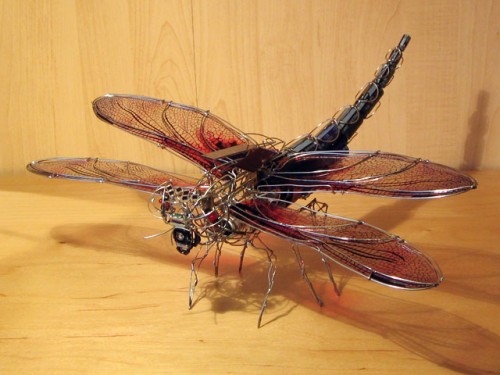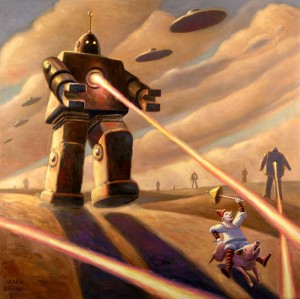David Calkins spoke at this month’s Ask a Scientist about robots. With infectious enthusiasm, he gave a brief overview of how robots have developed, how they’re used today, and what’s likely to happen with them in the near future. “This is Ask a Scientist – not Hear a Scientist Go On and On,” he said, and took loads of questions, all of which he answered with thought and style. And he closed with a delightful show and tell of soccer-playing, cartwheel-turning robots – you know, models that prove and demonstrate useful robotic strategies.
If you think about this stuff at all, the early part of the presentation was familiar ground. We’re not talking about automobile assembly arms or the Terminator series, but Calkins clearly focused on robots doing real work and on humanoid robots. Robots are already allowing physicians to practice some remarkably sophisticated medicine at a distance, including procedures, and remote-control devices reach even further, with several devices exploring Mars today. Back home, dishwashers, Roombas, and other household devices will, he says, continue to populate our homes and handle more of such straightforward tasks. And yes, homes can expect to keep featuring, for the most part, many single-purpose devices rather than being run by magically balancing, multipurpose Rosies.
What’s next? Is it only a matter of time before SkyNet becomes aware? Calkins says no; he believes that robots will never be alive, although they will continue to have their capacities for emulating human interaction refined. Because humans like that. He’s up front that ethics is a big issue for robotics, though. One of the most interested parties in robotics development is the US military, and if killing at a distance, say, by dropping a bomb from a plane, is a little “too easy,” psychologically speaking, how about killing at a distance where your interaction with your targets is represented on a screen? Not unlike a video game – right down to the operator being at little to no personal risk.
This isn’t Asimov’s-laws stuff. Does your Roomba need know you’re human, let alone have a working definition of harm? But robots that are in a position to intervene around humans can’t use overly simple rules like “do no harm;” they may have to manage, or accurately screen for human input, issues like “which figure in this room is the hostage taker?” At a time when robots can’t generally tell a cardboard cutout of Princess Leia from the real thing, a big dose of humane thinking has to stand between a robot and a robot carrying weapons.
The biggest limits on robots in the immediate future, says Calkins, are mainly about batteries, although ethics guidelines are a big need. He sees a lot more robotics being used in medicine, naming increasingly sophisticated control of prosthetics as a promising area. He wonders aloud whether people will start lining up for prosthetics as they become better (stronger, faster) than original human equipment. He sees this as a 10-year concern, although it’s hard to imagine medicine moving quickly enough to make prosthetic placement easy enough on the part of the body where a device is attached to make elective amputation attractive.
And then there’s just plain fun. Calkins is the founder of “the only event in the world that both Geeks and Jocks agree on:” RoboGames. “It’s kind of like a weird family reunion,” says a participant in a short video posted at the website. The single-minded focus and engineering ethos of participants – taking what they have and making what they need … or really really want – helps illuminate some of the cultural reasons that this is an area that is big on working models and light on formal policy statements. “Real men don’t have hobbies – they have obsessions.”



